High temperature epoxies adhesive formulations; all you need to know before you start formulation
High Temperature Epoxies are a type of adhesive formulation that is specifically designed to withstand extreme temperatures. These adhesives are used in a variety of industrial and commercial applications, including aerospace, automotive, and energy production. They are also commonly used in the construction of electronic devices and in the manufacturing of semiconductors.
Epoxy adhesives are known for their excellent strength and durability, making them ideal for use in high-temperature environments. They are also known for their excellent chemical resistance and ability to bond to a wide variety of materials, including metals, ceramics, and plastics.
High Temperature Epoxies are typically made from a combination of epoxy resin and a curing agent. The curing agent is responsible for activating the adhesive and hardening it over time. The curing agent can be either a liquid or a solid, and it is typically added to the epoxy resin in a specific ratio.
One of the key advantages of High Temperature Epoxies is their ability to withstand extreme temperatures. These adhesives can typically withstand temperatures up to 250 degrees Celsius (482 degrees Fahrenheit) without losing their strength or durability. This makes them ideal for use in applications where high temperatures are a concern, such as in the aerospace industry or in the construction of electronic devices.
Another advantage of High Temperature Epoxies is their excellent chemical resistance. These adhesives can withstand exposure to a wide range of chemicals, including acids, bases, and solvents. This makes them ideal for use in industrial environments where chemical exposure is a concern.
High Temperature Epoxies can also be formulated to meet specific performance requirements. For example, some formulations may be designed to be highly flexible, while others may be designed to be extremely strong. This allows manufacturers to choose the right adhesive for their specific application.
One of the most important factors to consider when using High Temperature Epoxies is the curing process. These adhesives typically require a specific curing process in order to activate and harden. This process can include heating the adhesive to a specific temperature, using UV light, or using a chemical curing agent. It is important to follow the manufacturer's instructions for the curing process in order to achieve the best results.
Another important factor to consider when using High Temperature Epoxies is the surface preparation. These adhesives typically require a clean and dry surface in order to achieve the best bond. It is important to thoroughly clean and dry the surface before applying the adhesive in order to achieve the best results.
High Temperature Epoxies are a versatile and durable adhesive solution that can be used in a wide range of industrial and commercial applications. They are known for their ability to withstand extreme temperatures and excellent chemical resistance, making them ideal for use in high-temperature environments. They can also be formulated to meet specific performance requirements, making them a flexible and customizable solution. However, it is essential to follow the manufacturer's instructions for the curing process and surface preparation in order to achieve the best results.
In conclusion, High Temperature Epoxies are a reliable and durable adhesive solution that can be used in a wide range of industrial and commercial applications. Their ability to withstand extreme temperatures and excellent chemical resistance make them ideal for use in high-temperature environments. They can also be formulated to meet specific performance requirements, making them a flexible and customizable solution. However, it is essential to follow the manufacturer's instructions for the curing process and surface preparation in order to achieve the best results.

